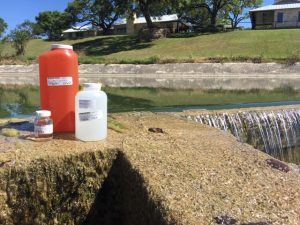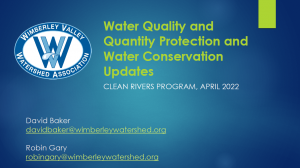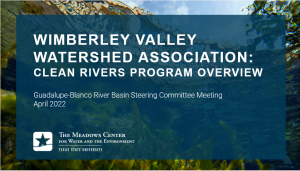 Monitoring the water quality of our springs, creeks, and rivers is an essential part of stewardship. It is impossible to manage what isn’t measured. The Watershed Association has been collecting quality assured water quality data since 2003 in collaboration with the Clean Rivers Program, a statewide water quality monitoring program run by the Texas Commission on Environmental Quality (TCEQ) and local river authorities. Currently, the Watershed Association contracts with the Meadows Center to monitor 10 quarterly sites and 2 monthly sites along Cypress Creek and the Blanco River. This data is compiled and verified by the Guadalupe Blanco River Authority (GBRA) and is used to assess whether surface water in the Blanco River and Cypress Creek is meeting Federal Clean Water Act standards.
Monitoring the water quality of our springs, creeks, and rivers is an essential part of stewardship. It is impossible to manage what isn’t measured. The Watershed Association has been collecting quality assured water quality data since 2003 in collaboration with the Clean Rivers Program, a statewide water quality monitoring program run by the Texas Commission on Environmental Quality (TCEQ) and local river authorities. Currently, the Watershed Association contracts with the Meadows Center to monitor 10 quarterly sites and 2 monthly sites along Cypress Creek and the Blanco River. This data is compiled and verified by the Guadalupe Blanco River Authority (GBRA) and is used to assess whether surface water in the Blanco River and Cypress Creek is meeting Federal Clean Water Act standards.
Each year, the GBRA hosts a Clean Rivers Coordinated Monitoring meeting for partner agencies. This year’s meeting was in person for the first time in several years, and there were several key updates we want to share:
Cypress Creek removed from the TCEQ’s list of impaired streams (303d list).
TCEQ determined that the dissolved oxygen data used in the previous analysis was not representative of annual flow conditions; the majority of the measurements were taken during the Critical Period (a period during which hydrologic, temperature, environmental, flow, and other such conditions result in a waterbody experiencing critical conditions with respect to an identified impairment). Dissolved oxygen is directly linked to flow. While it’s a relief to know that Cypress Creek was incorrectly listed as impaired in 2020, we’re in the midst of what could be an intense drought and spring flow is very low (between 1-2 cfs). Draft 2022 Texas Integrated Report – Water Bodies and Parameters Removed from the 303(d) List
Duplicate sampling of two sites on the Blanco River near Blanco.
TCEQ staff are monitoring the same two sites along the Blanco River near Blanco for nutrients and Chlorophyll-A, resulting in duplicate efforts. TCEQ has been sampling the FM 165 bridge and Blanco State Park sites quarterly. The Watershed Association began monthly sampling efforts at these sites starting in 2019. At the meeting, coordinating monitoring efforts between the Meadows Center and TCEQ will allow an additional site to be added upstream of the State Park near Blanco’s drinking water intake.
GBRA begins development of a Habitat Conservation Plan.
The Guadalupe-Blanco River Authority’s primary considerations for developing the GRHCP are to provide greater certainty in its ability to meet future water supply and wastewater treatment needs, while providing protections for threatened and endangered species in the Guadalupe River Basin. Several endangered or threatened salamanders, birds, mussels, and the Monarch butterfly will be considered as covered species. The GBRA manages water supply and wastewater permits throughout the basin, so the habitat conservation plan will define appropriate protections for the covered species affected by their covered activities. The first public stakeholder meeting will be June 28 at the GBRA River Annex. GBRA Habitat Conservation Plan Updates
Access data collected through the Clean Rivers Program at:

